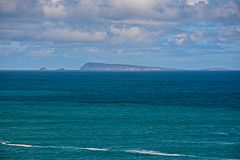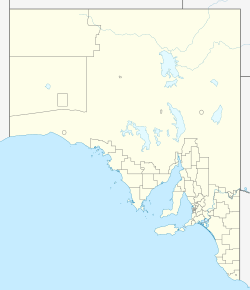Wedge Island (South Australia) facts for kids

View from Royston Head
|
|
| Geography | |
|---|---|
| Location | Spencer Gulf |
| Coordinates | 35°09′19″S 136°27′54″E / 35.1554°S 136.4649°E |
| Administration | |
|
Australia
|
|
Wedge Island is a special island in South Australia. It's part of a group called the Gambier Islands, located near the entrance to Spencer Gulf. Wedge Island is the biggest island in this group, covering about 10 square kilometers. Part of the island is owned by private individuals.
Contents
Exploring Wedge Island
At the highest point on the island's south-eastern side, you'll find the Wedge Island Lighthouse. There's also a small airstrip and a jetty, which is like a small pier for boats. No one lives on Wedge Island all the time, but there are buildings used for holidays. People also use the island as a base for fishing trips and for scuba diving.
A Look Back: Wedge Island's History
The island got its name in 1802 from a famous explorer named Matthew Flinders. People first settled on Wedge Island in the mid-1800s. Back then, it was a farm where they raised horses for the British Indian Army. For the next 130 years, people continued farming there, raising sheep and cattle, and growing wheat.
During World War II, Wedge Island played a role in Australia's defense. The Royal Australian Air Force (RAAF) used it as a radar station. They built a bunker near the lighthouse, and about 40 RAAF members lived there for several years, helping to keep watch.
Amazing Animals of Wedge Island
Island Wildlife
Wedge Island is home to many interesting animals. In 1928, people wrote about seeing lots of penguins with their young. At night, the island would echo with their unique calls. Quail birds were also common, flying up from the grass. High above, wedge-tailed eagles would fly in circles before landing on the rocky coast.
More details from 1929 mention many seabirds. Little penguins and Australian sea lions (sometimes called hair seals) live on Wedge Island. Around September, huge groups of "mutton birds" (which are actually short-tailed shearwaters) arrive. They breed a lot on nearby Gambier Island. Little penguins have been known to live on Wedge Island since at least 1924. In 2004, it was thought that fewer than 100 little penguins lived there.
New Animals on the Island
Over the years, some animals have been brought to Wedge Island by people.
- The island was once used to breed horses.
- Goats were also brought to the island and caused some damage.
- In the 1920s, there were many turkeys.
In 1971, Southern hairy-nosed Wombats were brought to the island to help attract visitors. Now, there are about 300 wombats living there! The endangered Brush-tailed Bettong, a small marsupial, has also been introduced to the island. This was done to help protect and increase the number of these special animals.
Wedge Island: An Important Bird Area
Wedge Island is recognized as an Important Bird Area by BirdLife International. This means it's a very important place for birds. The island supports more than 1% of the world's population of white-faced storm-petrels, with about 16,000 pairs breeding there.
Images for kids



